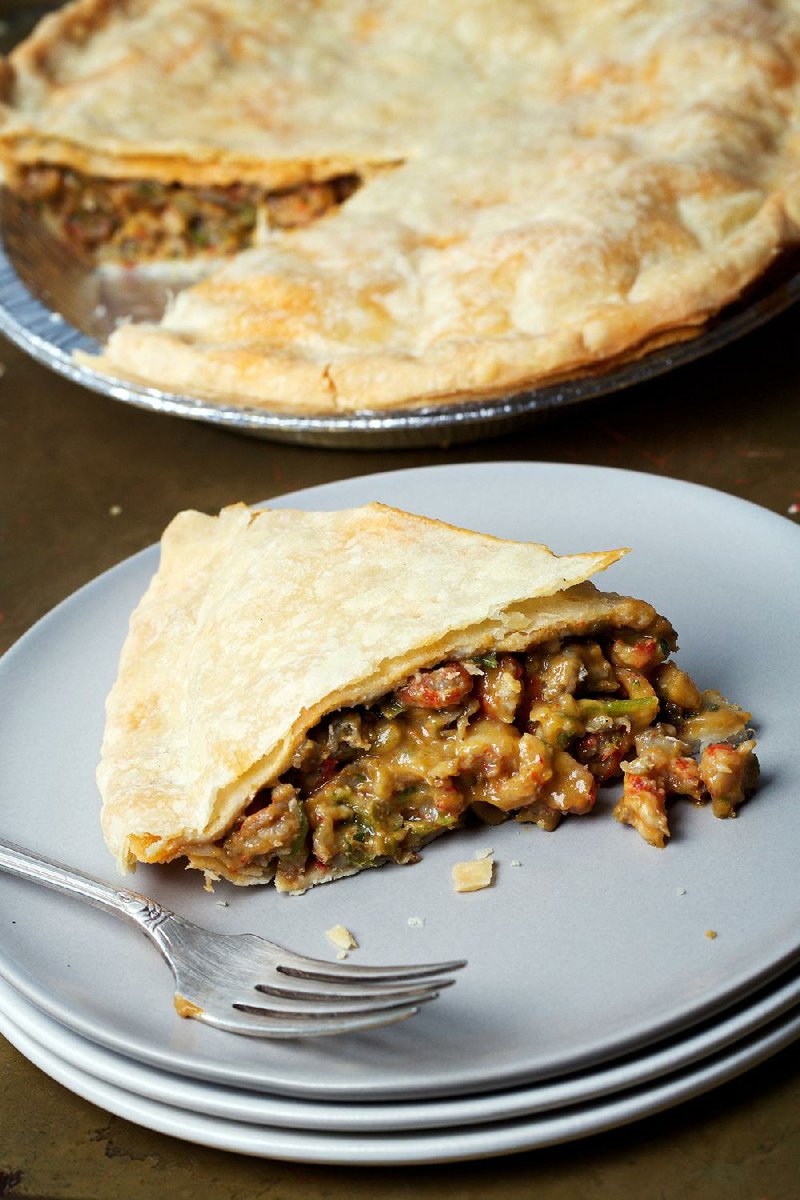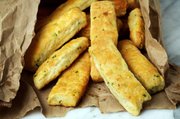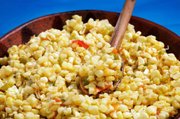It was always there. Woven into the fabric of almost every cooking memory, every kitchen, of my Louisiana childhood. There, along with the cast-iron pot, aluminum Magnalites and Chime-O-Matic rice cooker. Its mischievous plastic teeth underbiting the worn-out spiral binding, tattered yellow tabs frayed and curled, stamped with grease stains and reinforced with rubber bands. Four hundred fifty pages of green-inked recipes by the women whose footsteps paced the linoleum floors of the kitchens before us.
Talk About Good! was originally published in the summer of 1967 by the Junior League of Lafayette, La., as a community fundraiser. Fifty years, 30 editions and about 800,000 copies later, the book's yellow-and-white-striped cover occupies kitchen shelves across the region known as Acadiana -- and far beyond its borders.
The story of a community cookbook is the story of a community. Steeped in the tradition of hospitality and blessed with an abundance of natural culinary resources -- Gulf seafood, long-grain rice and sugar cane, to name a few -- this map dot known as Cajun country sustains one of the richest and most popular food cultures around. You may not be able to pronounce etouffee, but you probably know you want some.
Like the swirl of flour and oil that serves as the base for so many Cajun recipes, the roots of Talk About Good! are remarkably simple. Women in the organization culled their family and friends' recipe boxes and each submitted a handful of handwritten recipes, which, as the oral history goes, were never tested and throughout all 30 printings have never been edited. (Not even the infamous one -- none of the league members I talked to could remember which it is -- that calls for a whole cup of salt.)
Along with three other Cajun cookbooks the group publishes, Talk About Good! has raised about $1.2 million for "projects to promote the positive and healthy development of the families of the Lafayette community." The chapter's unrelenting focus on community service fundraising is evident, even in the way it's choosing to mark the cookbook's anniversary. Instead of fanfare, the Junior League of Lafayette has focused its efforts on offering an upgraded version of the book with a more durable concealed wire binding and commemorative $19.67 price tag.
"If you look back, there were thousands of community cookbooks like this published, but there are only a few that have kept on and on," said Alison Kelly, a research specialist and culinary expert at the Library of Congress. "It's pretty unique and confirms a lot of things we know about food traditions in Louisiana."
According to Laurie Dodge, director of marketing and development for the Association of Junior Leagues International, recipe books as fundraisers first became popular in the early 1940s. "In the early days, in addition to raising funds for the
community, it gave members an opportunity to run a business venture," Dodge said. "Women who weren't in the workforce could get marketing and business skills."
Former Lafayette Junior League president Sarah Berthelot emphasized that even though the capital city of Baton Rouge is only an hour away, there are distinct cultural differences. "The Lafayette area has a high concentration of descendants of the Acadian French people," she said, "so you see that French influence in the recipes."
"These were our early League members' most cherished recipes," Berthelot said. "Some of these recipes had been in their families for generations."
Even the name, Talk About Good! is a Cajun phrase, which evolved as a literal translation of the Cajun French expression "parles de bon." The book itself houses 1,200 authentic Cajun recipes -- from court bouillon and crawfish pie to stuffed mirlitons and maque choux -- some with a touch of late-'60s flair. The sparse pen-and-ink illustrations, created by one of the original cookbook committee members, Jane Flores, pay tribute to the region's unofficial icons: mossy live oaks, oil rigs, carnival masks and humble coffee pots.
"I think it's a wonderful way to honor our mothers and grandmothers and keep our heritage and tradition alive," said another former cookbook chairman, Carolyn Fontenot. "It was such a staple for any new bride. When women passed away, the daughter would take the cookbook. They would never throw away the original."
Sheila Thomas, publisher of Favorite Recipes Press, which specializes in community cookbooks, has been working with Talk About Good! in some capacity for her entire 25 years in publishing. She said the book was already considered old when she started in the business. "It's significant, not just for a Junior League cookbook, but for any cookbook to do that kind of print run," she said, referring to the about 800,000 copies sold. "It's amazing that a group of volunteers has run this cookbook business and continues to be successful."
My mom's edition, still in heavy rotation, lost its cover, introduction and table of contents a long time ago. It begins abruptly -- but festively -- with the "Mardi Gras" section. It's the book she and my dad turned to for Sunday dinners of rice and gravy and special-occasion breakfasts of egg casseroles and flour-dusted biscuits. She recently told me that for the longest time, it was the only cookbook she owned and the one she turned to for the jambalaya she made the first time she had her parents over for dinner.
My own copy was given to me by my husband's grandmother and my mother-in-law (whose own mother-in-law happens to be the author of "Congealed Asparagus Salad" on page 95). Members of his family wrote cooking tips in the margins as a special wedding gift. His grandmother passed away this year, and the curve of her handwritten "I love you" next to each piece of advice takes on an even deeper meaning.
For more information about the 50th anniversary edition of Talk About Good! visit, juniorleagueoflafayette.com/talk-about-good.
There are several recipes for crawfish pie filling in the Junior League of Lafayette's popular Talk About Good! cookbook, but this one, credited to Mrs. Carmen Montegut, comes highly recommended. It does take a bit of time, so be patient.
The filling can be served over rice, etouffee-style, if desired.
Crawfish Pie
For the crust:
4 cups sifted flour, plus more for rolling
2 teaspoons salt
4 heaping tablespoons vegetable shortening, plus more as needed
1 1/3 cups cold water, or more as needed
For the filling:
1 cup (2 sticks) unsalted butter, cut into pieces
1/2 cup flour
2 cloves garlic
1 medium onion, cut into small dice
2 bunches green onions, chopped (white and light-green parts, reserve and chop dark-green parts)
1 green bell pepper, seeded and finely diced
1 cup diced celery
3 tablespoons tomato sauce
Salt and ground black pepper
Ground red pepper (cayenne)
3 cups water, or more as needed
3 pounds cooked, frozen/defrosted crawfish tails
2 tablespoons cornstarch mixed with just enough water to form a creamy consistency (slurry; optional)
1 bunch parsley, chopped
For the crust: Combine the flour and salt in a mixing bowl. Use a pastry cutter or two forks to cut in the 4 tablespoons of shortening. Gradually add the water to form a dough that holds together.
Flour a work surface. Roll out the dough there into a large rectangle. Coat lightly with shortening, then sift a light dusting of flour over the shortening. Fold in the sides, one and then the other so that they touch each other at the center. Grease the new surfaces lightly with shortening and dust with sifted flour. Cover loosely and let sit at room temperature for 30 minutes.
Roll out, fold, grease and dust with sifted flour two more times, with 30-minute rests in between each one. Divide the dough into 4 equal portions. You'll need 2 portions of dough for each pie.
Roll out 2 portions of dough into 2 (11-inch) rounds, on the flour-dusted surface, then gently transfer them to 9-inch pie plates and fit all the way around, crimping the edges decoratively. The crust can be wrapped and refrigerated until ready to use (up to 1 day in advance). Wrap and refrigerate the remaining portions of dough.
For the filling: Melt the butter in a large saute pan over medium heat. Stir in the flour; cook long enough for it to lightly brown (this is a roux).
Add the garlic, onion, chopped green onions, green bell pepper, celery and tomato sauce. Season well with salt, black pepper and a pinch of cayenne pepper. Cover and cook for about 1 hour, stirring frequently to keep the vegetables from sticking.
Add the water and cook, uncovered, for several hours. If the mixture thickens too much, add more water; the mixture should be creamy and thick. Stir in the crawfish tails; cook for 5 minutes, or just until tails are tender.
If mixture becomes thin, you can thicken it by stirring in the cornstarch slurry, if using, and cooking for a few extra minutes. Add the chopped, dark-green onion tops and the parsley. Taste and season with more salt and/or black pepper, as needed. Let cool for a bit.
Heat oven to 350 degrees. Use a fork to dock several holes in the bottom pie dough crusts. Flour the work surface again, as needed, and roll out the remaining portions of dough into 2 (11-inch) rounds.
Divide and pour the filling into bottom crusts. Cover with the rolled-out top crusts, crimping the edges to seal in a decorative fashion. Cut slits in the top crusts. Place the pies on a baking sheet and bake (middle rack) for about 15 minutes. Reduce the temperature to 300 degrees; bake for 15 to 25 minutes or until golden brown.
Let cool for 10 minutes before cutting and serving.
Makes 2 pies (about 12 servings).
These old-fashioned biscuits get their name because they bake in melted butter, creating a golden brown bottom crust.
Butter Dips
5 tablespoons unsalted butter
2 1/4 cups sifted flour, plus more for the work surface
1 tablespoon sugar
1 tablespoon PLUS 1/2 teaspoon baking powder
1 1/2 teaspoons salt
1 cup whole milk
Heat oven to 400 degrees.
Place the butter in 9-by-13-inch baking dish; let it melt in the oven, then remove from the oven.
Meanwhile, sift together flour, sugar, baking powder and salt in a mixing bowl, then add the milk. Stir slowly with a fork until the dough just clings together.
Generously flour a work surface. Transfer the dough there, and dust lightly with flour on both sides. Gently knead about 10 times, then roll out to an 8-by-12-inch rectangle that's about 1/2 inch thick.
Cut the dough in half lengthwise, then cut crosswise into 16 equal strips.
Working with one strip at a time, use both hands to pick it up and dip it into the melted butter in the pan, coating both sides. Arrange all the strips close together in the pan as you go. Bake 20 to 22 minutes, until golden brown.
Serve hot.
Makes 32 sticks.
Variations
• Add 1/2 cup grated sharp American cheese to the dry ingredients.
• Add half a clove's worth of finely minced garlic to the butter before it melts in the oven.
• Sprinkle sweet paprika, celery seed or garlic salt over the butter dips before baking.
• Add 1/2 cup minced chives or parsley to flour mixture.
This side dish shows up on a lot of Thanksgiving tables in New Orleans. Use the freshest corn you can find, and don't skimp on the bacon fat. This version is credited to Mrs. P.J. Blanchet Jr.
Maque Choux
8 ears corn, shucked
1/2 cup rendered bacon fat
1/2 medium white onion, chopped
1/4 cup red bell pepper, chopped
1/2 cup peeled, chopped tomato
1 teaspoon sugar
Salt and ground black pepper
Use a sharp chef's knife to cut off the corn kernels inside a large mixing bowl, then use the blunt side of the blade to scrape each cleaned cob, letting their milky liquid drip into the bowl as well. (Reserve the cobs for making broth, if desired.)
Heat the bacon fat in a large skillet or saute pan over medium heat. Once it's sizzling, pour into heat-safe measuring cup.
Add the corn and its liquid, the onion, bell pepper, tomato and sugar to the skillet. Season generously with salt and pepper, stirring to incorporate. Pour the hot bacon fat over the corn mixture; reduce the heat to low, cover and cook for 45 minutes, stirring occasionally.
Taste and add more salt and/or pepper, as needed. Serve warm.
Makes about 8 cups.
Recipes adapted from Talk About Good! by the Junior League of Lafayette, Louisiana (Favorite Recipes Press, 1969 edition)
Food on 08/23/2017


